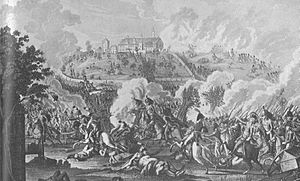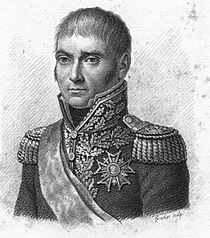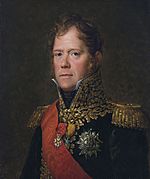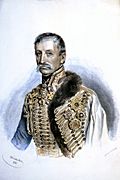Battle of Elchingen facts for kids
Quick facts for kids Battle of Elchingen |
|||||||
|---|---|---|---|---|---|---|---|
| Part of the War of the Third Coalition | |||||||
 Battle of Elchingen from an engraving by Johann Lorenz Rugendas. French infantry storm the abbey while dragoons chase fleeing Austrians. |
|||||||
|
|||||||
| Belligerents | |||||||
| Commanders and leaders | |||||||
| Units involved | |||||||
| VI Corps (Grande Armée) | Riesch's Corps | ||||||
| Strength | |||||||
| 17,000 | 16,000 | ||||||
| Casualties and losses | |||||||
| 793–854 | 6,000 | ||||||
The Battle of Elchingen was a key fight during the Ulm Campaign in 1805. On October 14, French forces, led by Michel Ney, defeated an Austrian army corps. This battle was important because it helped trap a large part of the Austrian army inside the fortress of Ulm.
After this defeat, many Austrian soldiers were stuck in Ulm by Emperor Napoleon Bonaparte's army. Other Austrian groups tried to escape to the east. Soon after, the Austrians in Ulm had to surrender. The French then captured most of the remaining Austrian forces, bringing the Ulm Campaign to an end.
In late September and early October 1805, Napoleon planned a huge trap for the Austrian army in Bavaria. This army was led by Karl Mack von Lieberich. While the Austrians were near Ulm, south of the Danube River, the French army marched west on the north side of the river. Napoleon's troops then crossed the river east of Ulm. This cut off the Austrian escape route to Vienna.
When Mack finally realized the danger, he tried to break out on the north side of the river. However, a single French division stopped his first attempt. Napoleon knew his enemies might get away. So, he ordered Marshal Ney to cross to the north bank of the river. Ney's larger army attacked the Austrian forces led by Johann Sigismund Riesch at Elchingen. The French captured the high ground and pushed the Austrian soldiers west towards Ulm. Many Austrians were forced to surrender. Even though some Austrians were still free on the north bank, Riesch's defeat meant that most of Mack's army was completely surrounded in Ulm.
Contents
Why the Battle of Elchingen Happened
On September 8, 1805, the Austrian army, led by Karl Mack von Lieberich and Archduke Ferdinand, entered Bavaria. Mack first planned to gather his army near Augsburg. However, the ruler of Bavaria, Elector Maximilian IV Joseph, chose to side with France. He moved his army away from the Austrians.
By September 12, Mack changed his plan. He decided to gather his army further west, near the Iller River and Ulm. He wanted to be ready to fight any French attack coming from the Black Forest. But this change caused problems with the army's supplies. The weather got bad, and soldiers started getting sick or leaving the army. Archduke Ferdinand and Mack's chief of staff disagreed with Mack's new plan. Their relationship became very difficult.
Emperor Francis II supported Mack, even though his top general, Archduke Charles, warned him that Mack was making a mistake. On September 24, Napoleon's huge army, the Grande Armée, began to cross the Rhine River. This started the Ulm Campaign. While some French forces moved directly towards Ulm, most of Napoleon's army marched north of the Austrian army. They then turned south, crossing the Danube River. This move cut off the Austrian retreat route.
By this time, Mack's army was divided into four main groups. Mack decided to defend Ulm, which was a bad choice. He should have tried to escape the approaching French army.
Mack sent a small force of 6,000 men to stop the French. But the French, led by Joachim Murat and Jean Lannes, easily defeated them at the Battle of Wertingen. The Austrians lost many soldiers. The next day, the French attacked Austrian troops at the Battle of Günzburg, causing more losses for the Austrians.
Napoleon sent some of his forces to guard against a Russian army and other Austrian troops. The rest of his army moved west towards Ulm. On October 11, a small French division, led by Pierre Dupont, was attacked by a large Austrian force of 25,000 men at the Battle of Haslach-Jungingen. Dupont's smaller force fought bravely and held their ground, even though they suffered many casualties.
After this fight, Mack returned to Ulm. On October 12, he reorganized his army. He then gave many confusing orders, often changing them. He ordered some troops to march south, others to stay at Ulm, and some to move north. One of his orders sent General Riesch and his troops towards Elchingen. Meanwhile, on October 13, Napoleon realized that the Austrians might try to escape on the north side of the Danube. He ordered Ney and Murat to move their forces to the north bank the next day.
The Battle of Elchingen Begins
Austrian Defenses
On October 13, General Riesch arrived at Elchingen. He found some French soldiers already fighting for control of the bridge over the Danube. Riesch decided not to attack strongly. Instead, he just placed his troops to defend the north bank of the river. He left the bridge mostly intact, with the French still controlling the south end. He then ordered his soldiers to set up camp at Elchingen. It seems Riesch might have lost faith in Mack's leadership.
Riesch's Austrian force had about 8,000 men. They were positioned on high ground near the villages of Ober- and Unter-Elchingen. They had 14 battalions of infantry, 11 squadrons of cavalry, and 12 cannons ready to defend their position.
French Attack Force
Facing the Austrians was Marshal Ney's French VI Corps. This force included two infantry divisions and a cavalry division. They also had a reinforced dragoon brigade and 28 cannons. In total, the French had about 6,800 infantry, 1,100 cavalry, and 485 artillerymen with their guns ready for the attack.
The French Attack
Marshal Ney planned for his soldiers to attack across a partly broken bridge directly south of Riesch's position. Once the bridge was secure, Joachim Murat would send cavalry to help. Another French division would cross the Danube further east and then sweep west along the north bank.
At 8:00 am, Ney sent his best soldiers across the bridge. They quickly defeated the Austrian guards. French engineers quickly fixed the bridge. When Riesch sent two battalions to stop them, they were pushed back by more and more French soldiers crossing the bridge.
The French brigade, led by General Villatte, then attacked the main Austrian position. French cavalry and cannons supported them. Marshal Ney himself led the attack. The 6th Light Infantry Regiment quickly captured the Elchingen Abbey and most of Ober-Elchingen. The 39th Line Infantry Regiment was pushed back by Austrian cavalry, but General Loison brought up more French troops to help. The 69th Line Infantry Regiment helped push Riesch's men back into the Grosser Forest.
With another French division threatening from the east and Dupont's troops from the northeast, Riesch began to retreat. French dragoons broke through an Austrian square (a defensive formation) after it was weakened by French gunfire. Other French dragoons joined the chase. The Austrians tried one last cavalry charge, but it was stopped by French infantry and then counter-attacked by French cavalry.
Outcome of the Battle
The French reported losing 56 officers and 737 soldiers killed or wounded. They captured 4,000 Austrian soldiers and 4 cannons. The Austrians likely had up to 2,000 soldiers killed or wounded.
The remaining Austrian soldiers from Riesch's force retreated to Ulm, where they were trapped with General Mack's main army. On October 14, Archduke Ferdinand managed to escape from Ulm with a cavalry regiment. However, large parts of the Austrian army were still caught in Napoleon's trap.
Mack and 23,500 Austrian troops, along with 60 cannons, surrendered at the Battle of Ulm on October 20. In the days that followed, French forces chased down and captured most of the remaining Austrian groups. Only a few Austrian leaders and some cavalry managed to escape into Bohemia. Far to the south, another group of 4,000 Austrian soldiers surrendered to the French on November 13.
In 1808, Napoleon honored Marshal Ney for his victory at Elchingen by giving him the title "Duke of Elchingen."







